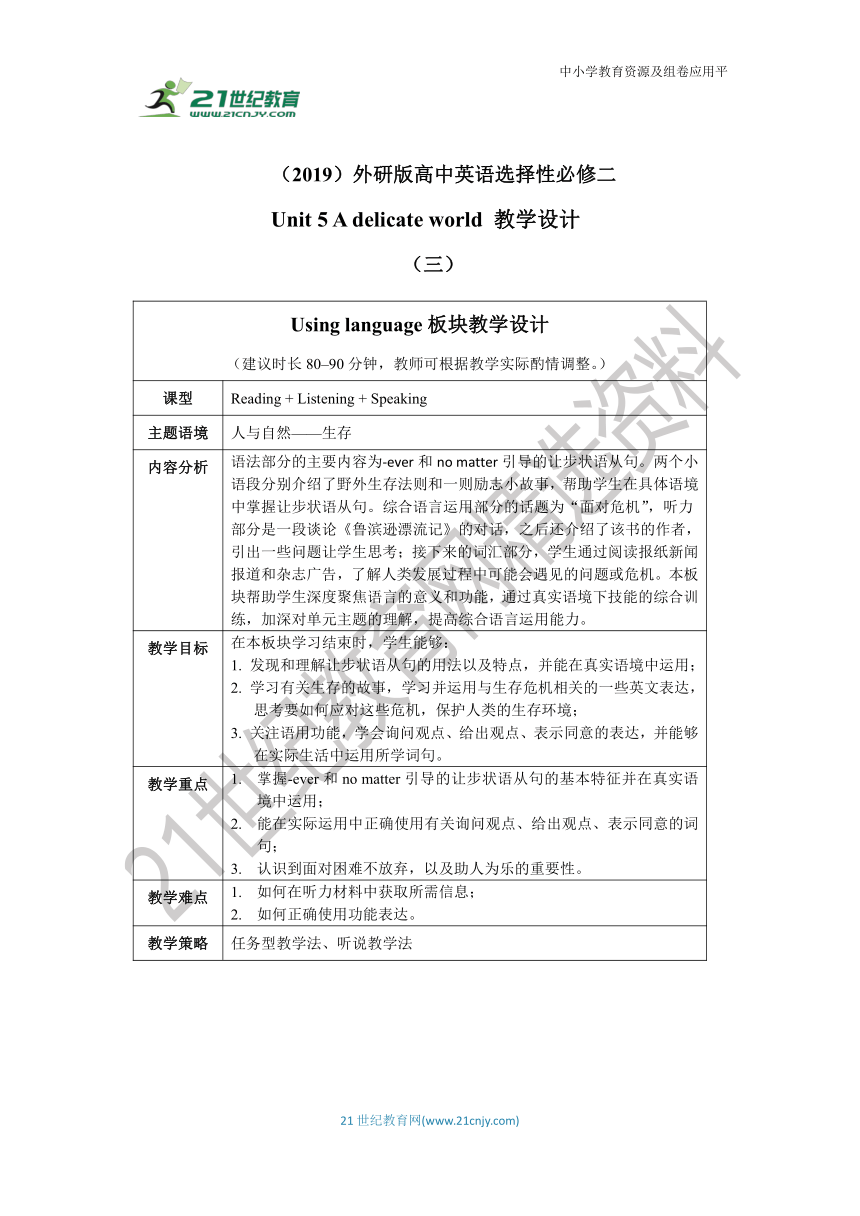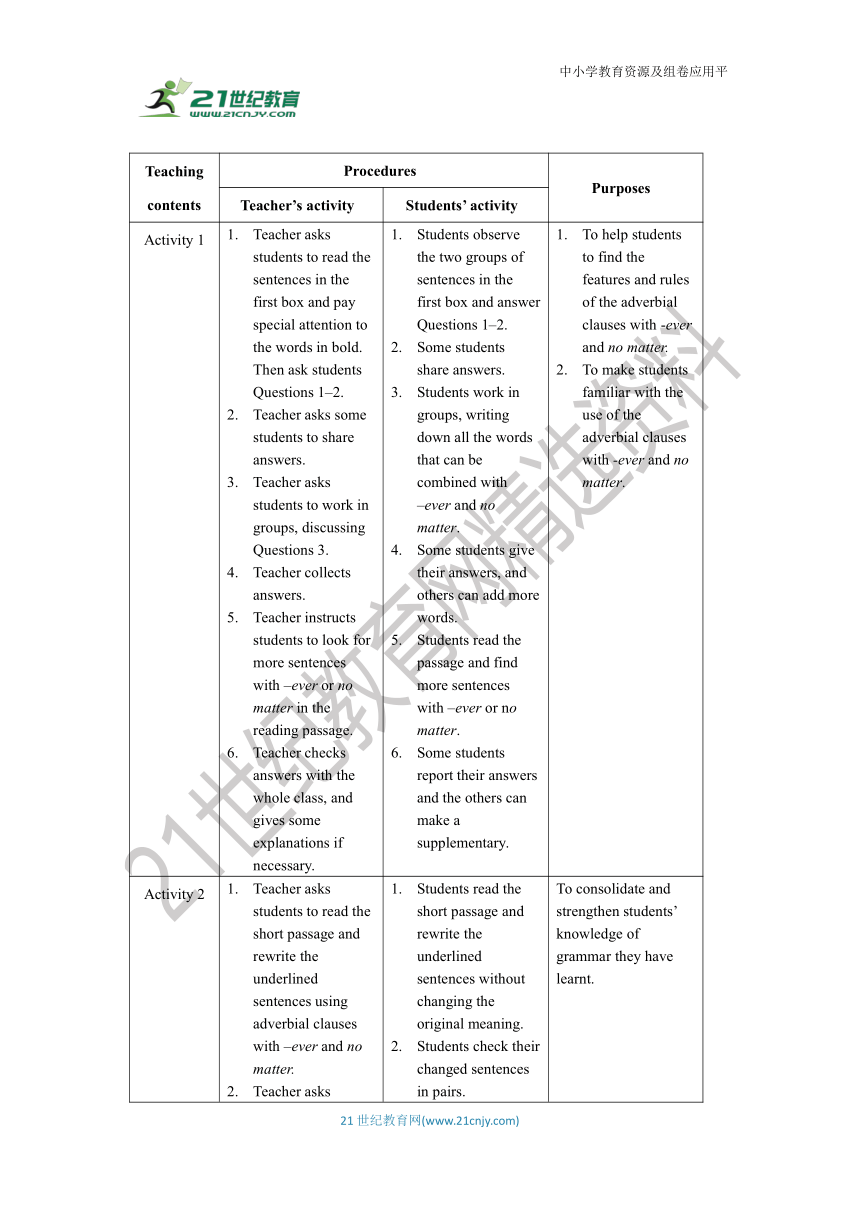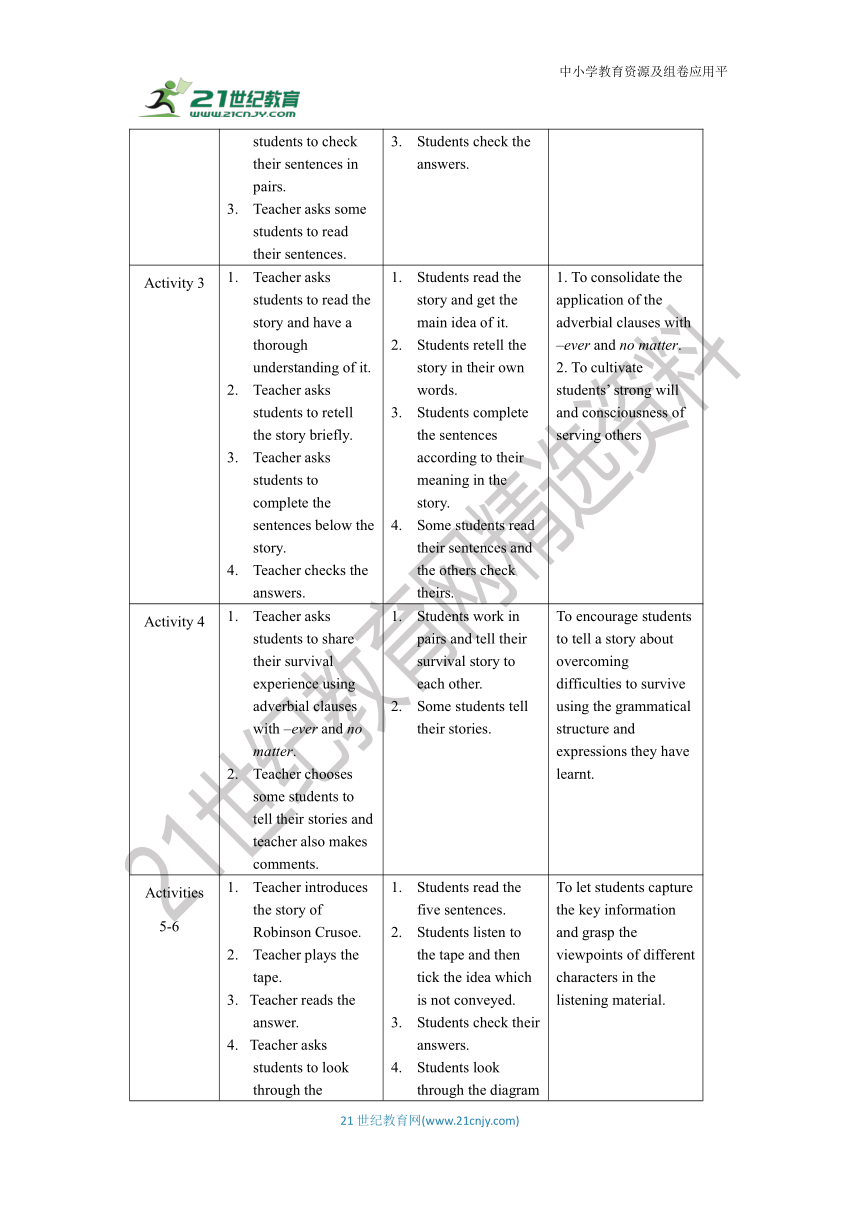Unit 6 Survival(三)Using language 教学设计
文档属性
| 名称 | Unit 6 Survival(三)Using language 教学设计 |  | |
| 格式 | doc | ||
| 文件大小 | 1.3MB | ||
| 资源类型 | 试卷 | ||
| 版本资源 | 外研版(2019) | ||
| 科目 | 英语 | ||
| 更新时间 | 2021-12-16 11:05:14 | ||
图片预览



文档简介
中小学教育资源及组卷应用平
Using language板块教学设计(建议时长80–90分钟,教师可根据教学实际酌情调整。)
课型 Reading + Listening + Speaking
主题语境 人与自然——生存
内容分析 语法部分的主要内容为-ever和no matter引导的让步状语从句。两个小语段分别介绍了野外生存法则和一则励志小故事,帮助学生在具体语境中掌握让步状语从句。综合语言运用部分的话题为“面对危机”,听力部分是一段谈论《鲁滨逊漂流记》的对话,之后还介绍了该书的作者,引出一些问题让学生思考;接下来的词汇部分,学生通过阅读报纸新闻报道和杂志广告,了解人类发展过程中可能会遇见的问题或危机。本板块帮助学生深度聚焦语言的意义和功能,通过真实语境下技能的综合训练,加深对单元主题的理解,提高综合语言运用能力。
教学目标 在本板块学习结束时,学生能够:1. 发现和理解让步状语从句的用法以及特点,并能在真实语境中运用;2. 学习有关生存的故事,学习并运用与生存危机相关的一些英文表达,思考要如何应对这些危机,保护人类的生存环境;3. 关注语用功能,学会询问观点、给出观点、表示同意的表达,并能够在实际生活中运用所学词句。
教学重点 掌握-ever和no matter引导的让步状语从句的基本特征并在真实语境中运用;能在实际运用中正确使用有关询问观点、给出观点、表示同意的词句;认识到面对困难不放弃,以及助人为乐的重要性。
教学难点 如何在听力材料中获取所需信息;如何正确使用功能表达。
教学策略 任务型教学法、听说教学法
(2019)外研版高中英语选择性必修二
Unit 5 A delicate world 教学设计
(三)
Teaching contents Procedures Purposes
Teacher’s activity Students’ activity
Activity 1 Teacher asks students to read the sentences in the first box and pay special attention to the words in bold. Then ask students Questions 1–2.Teacher asks some students to share answers.Teacher asks students to work in groups, discussing Questions 3.Teacher collects answers.Teacher instructs students to look for more sentences with –ever or no matter in the reading passage.Teacher checks answers with the whole class, and gives some explanations if necessary. Students observe the two groups of sentences in the first box and answer Questions 1–2.Some students share answers.Students work in groups, writing down all the words that can be combined with –ever and no matter.Some students give their answers, and others can add more words.Students read the passage and find more sentences with –ever or no matter.Some students report their answers and the others can make a supplementary. To help students to find the features and rules of the adverbial clauses with -ever and no matter.To make students familiar with the use of the adverbial clauses with -ever and no matter.
Activity 2 Teacher asks students to read the short passage and rewrite the underlined sentences using adverbial clauses with –ever and no matter. Teacher asks students to check their sentences in pairs.Teacher asks some students to read their sentences. Students read the short passage and rewrite the underlined sentences without changing the original meaning.Students check their changed sentences in pairs.Students check the answers. To consolidate and strengthen students’ knowledge of grammar they have learnt.
Activity 3 Teacher asks students to read the story and have a thorough understanding of it.Teacher asks students to retell the story briefly.Teacher asks students to complete the sentences below the story.Teacher checks the answers. Students read the story and get the main idea of it.Students retell the story in their own words.Students complete the sentences according to their meaning in the story. Some students read their sentences and the others check theirs. 1. To consolidate the application of the adverbial clauses with –ever and no matter. 2. To cultivate students’ strong will and consciousness of serving others
Activity 4 Teacher asks students to share their survival experience using adverbial clauses with –ever and no matter. Teacher chooses some students to tell their stories and teacher also makes comments. Students work in pairs and tell their survival story to each other. Some students tell their stories. To encourage students to tell a story about overcoming difficulties to survive using the grammatical structure and expressions they have learnt.
Activities 5-6 Teacher introduces the story of Robinson Crusoe. Teacher plays the tape.Teacher reads the answer. Teacher asks students to look through the diagram carefully and pay attention to the missing information.Teacher plays the tape again.Teacher plays the tape once more.Teacher read the answers.Teacher asks students to talk about what made Robinson Crusoe survive according to the dialogue. Teacher asks volunteers to share their opinions. Students read the five sentences.Students listen to the tape and then tick the idea which is not conveyed.Students check their answers.Students look through the diagram carefully.Students listen to the tape and take notes. Then complete the diagram.Students listen and check their answers.Students check their answers.Students work in pairs talking about what made Robinson Crusoe survive.Volunteers share their opinions. To let students capture the key information and grasp the viewpoints of different characters in the listening material.
Activity 7 Teacher asks students to go through the expressions.Teacher asks students to complete the boxes with the expressions.Teacher checks the answer. Students read the expressions and understand their meaning.Students put the expressions in the boxes according to their functions.One student reads the expressions in the boxes and the others check their answers. To make students pay attention to the pragmatic functions of different expressions.
Activity 8 Teacher asks students to read the passage.Teacher asks students to retell the passage.Teacher asks students to discuss the two questions.Teacher checks the answers with the class. Students read the passage and understand the meaning.Students retell the passage briefly. Students work in groups and answer the two questions.Some students give their answers. 1. To have students learn about Daniel Defoe, author of Robinson Crusoe.2. To have students learn about Robinson Crusoe’s positive, optimistic and courageous spirit to overcome difficulties. 3. To help students think about various crises in different parts of the world and how to cope with them.
Activity 9-10 Teacher asks students to read the five news reports and pay attention to the expressions in bold.Teacher checks students’ understanding of the five reports.Teacher asks students to answer the two questions.Teacher collects answers and makes comments.Teacher asks students to read the advertisement. Teacher asks students to finish the task in Activity 10.Teacher checks the answer. Teacher invites some students to retell the advertisement after it is rewritten. Students read the five news reports and understand their meaning.Some students retell the five reports. Students discuss the two questions in groups and answer them.Some students share their answers.Students read the advertisement carefully.Students rewrite the underlined expressions with the correct form of words and expressions in Activity 9.Some students share their answers. Volunteers retell the advertisement after the underlined expressions are rewritten. 1. To help students understand news report.2. To help students consolidate the vocabulary they have learnt.3. To let students experience the diversity of expressions of the English language.
Activity 11 Teacher asks students to make a dialogue about an issue concerning a survival and how to deal with it.Teacher asks students to perform their dialogues in groups.Teacher invites several pairs to act out their dialogues and makes comments. Teacher asks students to choose the best one. Students work in pairs. Think of an issue concerning a survival and how to deal with it. Then make a dialogue about it. Students act out their dialogues in groups and make comments on each other’ s dialogue.Several pairs act out their dialogues in front of the class.Students choose the dialogue they like best. 1.To encourage students to comprehensively use the vocabulary and pragmatic functional expressions in specific situations 2. To help students to carry out mutual evaluation after an activity, so as to improve students’ critical thinking ability and pave the way for future study.
HYPERLINK "http://www.21cnjy.com/" 21世纪教育网(www.21cnjy.com)
Using language板块教学设计(建议时长80–90分钟,教师可根据教学实际酌情调整。)
课型 Reading + Listening + Speaking
主题语境 人与自然——生存
内容分析 语法部分的主要内容为-ever和no matter引导的让步状语从句。两个小语段分别介绍了野外生存法则和一则励志小故事,帮助学生在具体语境中掌握让步状语从句。综合语言运用部分的话题为“面对危机”,听力部分是一段谈论《鲁滨逊漂流记》的对话,之后还介绍了该书的作者,引出一些问题让学生思考;接下来的词汇部分,学生通过阅读报纸新闻报道和杂志广告,了解人类发展过程中可能会遇见的问题或危机。本板块帮助学生深度聚焦语言的意义和功能,通过真实语境下技能的综合训练,加深对单元主题的理解,提高综合语言运用能力。
教学目标 在本板块学习结束时,学生能够:1. 发现和理解让步状语从句的用法以及特点,并能在真实语境中运用;2. 学习有关生存的故事,学习并运用与生存危机相关的一些英文表达,思考要如何应对这些危机,保护人类的生存环境;3. 关注语用功能,学会询问观点、给出观点、表示同意的表达,并能够在实际生活中运用所学词句。
教学重点 掌握-ever和no matter引导的让步状语从句的基本特征并在真实语境中运用;能在实际运用中正确使用有关询问观点、给出观点、表示同意的词句;认识到面对困难不放弃,以及助人为乐的重要性。
教学难点 如何在听力材料中获取所需信息;如何正确使用功能表达。
教学策略 任务型教学法、听说教学法
(2019)外研版高中英语选择性必修二
Unit 5 A delicate world 教学设计
(三)
Teaching contents Procedures Purposes
Teacher’s activity Students’ activity
Activity 1 Teacher asks students to read the sentences in the first box and pay special attention to the words in bold. Then ask students Questions 1–2.Teacher asks some students to share answers.Teacher asks students to work in groups, discussing Questions 3.Teacher collects answers.Teacher instructs students to look for more sentences with –ever or no matter in the reading passage.Teacher checks answers with the whole class, and gives some explanations if necessary. Students observe the two groups of sentences in the first box and answer Questions 1–2.Some students share answers.Students work in groups, writing down all the words that can be combined with –ever and no matter.Some students give their answers, and others can add more words.Students read the passage and find more sentences with –ever or no matter.Some students report their answers and the others can make a supplementary. To help students to find the features and rules of the adverbial clauses with -ever and no matter.To make students familiar with the use of the adverbial clauses with -ever and no matter.
Activity 2 Teacher asks students to read the short passage and rewrite the underlined sentences using adverbial clauses with –ever and no matter. Teacher asks students to check their sentences in pairs.Teacher asks some students to read their sentences. Students read the short passage and rewrite the underlined sentences without changing the original meaning.Students check their changed sentences in pairs.Students check the answers. To consolidate and strengthen students’ knowledge of grammar they have learnt.
Activity 3 Teacher asks students to read the story and have a thorough understanding of it.Teacher asks students to retell the story briefly.Teacher asks students to complete the sentences below the story.Teacher checks the answers. Students read the story and get the main idea of it.Students retell the story in their own words.Students complete the sentences according to their meaning in the story. Some students read their sentences and the others check theirs. 1. To consolidate the application of the adverbial clauses with –ever and no matter. 2. To cultivate students’ strong will and consciousness of serving others
Activity 4 Teacher asks students to share their survival experience using adverbial clauses with –ever and no matter. Teacher chooses some students to tell their stories and teacher also makes comments. Students work in pairs and tell their survival story to each other. Some students tell their stories. To encourage students to tell a story about overcoming difficulties to survive using the grammatical structure and expressions they have learnt.
Activities 5-6 Teacher introduces the story of Robinson Crusoe. Teacher plays the tape.Teacher reads the answer. Teacher asks students to look through the diagram carefully and pay attention to the missing information.Teacher plays the tape again.Teacher plays the tape once more.Teacher read the answers.Teacher asks students to talk about what made Robinson Crusoe survive according to the dialogue. Teacher asks volunteers to share their opinions. Students read the five sentences.Students listen to the tape and then tick the idea which is not conveyed.Students check their answers.Students look through the diagram carefully.Students listen to the tape and take notes. Then complete the diagram.Students listen and check their answers.Students check their answers.Students work in pairs talking about what made Robinson Crusoe survive.Volunteers share their opinions. To let students capture the key information and grasp the viewpoints of different characters in the listening material.
Activity 7 Teacher asks students to go through the expressions.Teacher asks students to complete the boxes with the expressions.Teacher checks the answer. Students read the expressions and understand their meaning.Students put the expressions in the boxes according to their functions.One student reads the expressions in the boxes and the others check their answers. To make students pay attention to the pragmatic functions of different expressions.
Activity 8 Teacher asks students to read the passage.Teacher asks students to retell the passage.Teacher asks students to discuss the two questions.Teacher checks the answers with the class. Students read the passage and understand the meaning.Students retell the passage briefly. Students work in groups and answer the two questions.Some students give their answers. 1. To have students learn about Daniel Defoe, author of Robinson Crusoe.2. To have students learn about Robinson Crusoe’s positive, optimistic and courageous spirit to overcome difficulties. 3. To help students think about various crises in different parts of the world and how to cope with them.
Activity 9-10 Teacher asks students to read the five news reports and pay attention to the expressions in bold.Teacher checks students’ understanding of the five reports.Teacher asks students to answer the two questions.Teacher collects answers and makes comments.Teacher asks students to read the advertisement. Teacher asks students to finish the task in Activity 10.Teacher checks the answer. Teacher invites some students to retell the advertisement after it is rewritten. Students read the five news reports and understand their meaning.Some students retell the five reports. Students discuss the two questions in groups and answer them.Some students share their answers.Students read the advertisement carefully.Students rewrite the underlined expressions with the correct form of words and expressions in Activity 9.Some students share their answers. Volunteers retell the advertisement after the underlined expressions are rewritten. 1. To help students understand news report.2. To help students consolidate the vocabulary they have learnt.3. To let students experience the diversity of expressions of the English language.
Activity 11 Teacher asks students to make a dialogue about an issue concerning a survival and how to deal with it.Teacher asks students to perform their dialogues in groups.Teacher invites several pairs to act out their dialogues and makes comments. Teacher asks students to choose the best one. Students work in pairs. Think of an issue concerning a survival and how to deal with it. Then make a dialogue about it. Students act out their dialogues in groups and make comments on each other’ s dialogue.Several pairs act out their dialogues in front of the class.Students choose the dialogue they like best. 1.To encourage students to comprehensively use the vocabulary and pragmatic functional expressions in specific situations 2. To help students to carry out mutual evaluation after an activity, so as to improve students’ critical thinking ability and pave the way for future study.
HYPERLINK "http://www.21cnjy.com/" 21世纪教育网(www.21cnjy.com)
